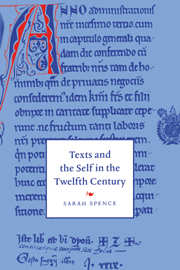Book contents
- Frontmatter
- Contents
- Acknowledgements
- 1 Corpus, body, text (and self)
- 2 Writing out the body: Abbot Suger, De administratione
- 3 Text of the body: Abelard and Guibert de Nogent
- 4 Text of the self: Guilhem IX and Jaufre Rudel, Bernart de Ventadorn and Raimbaut d'Aurenga
- 5 Writing in the vernacular: the Lais of Marie de France
- 6 Conclusion
- Works cited
- Index
- Cambridge Studies in Medieval Literature
3 - Text of the body: Abelard and Guibert de Nogent
Published online by Cambridge University Press: 08 January 2010
- Frontmatter
- Contents
- Acknowledgements
- 1 Corpus, body, text (and self)
- 2 Writing out the body: Abbot Suger, De administratione
- 3 Text of the body: Abelard and Guibert de Nogent
- 4 Text of the self: Guilhem IX and Jaufre Rudel, Bernart de Ventadorn and Raimbaut d'Aurenga
- 5 Writing in the vernacular: the Lais of Marie de France
- 6 Conclusion
- Works cited
- Index
- Cambridge Studies in Medieval Literature
Summary
Peter Abelard's associations with the Abbey of Saint-Denis are well-documented; his philosophical differences with Suger well known. Yet in the Historia calamitatum Abelard demonstrates a textual position similar to that of Suger in the De administratione. If Suger's writings are remarkable for their ability to reveal and conceal the body at the same time – to proselytize a line of nostalgic purity while undermining that purity by grounding it in the body – then Abelard's writings are striking for their utter lack of nostalgia coupled with their assurance that man's relative ineffectuality is not shared by his text. For in Abelard's autobiographical work, the Historia calamitatum, the text comes close to enabling the body to transcend its quidditas; as the text becomes identified with the frailties and limitations of the body, it comes to represent a potential and new-found strength.
The autobiographical context: Abelard, Augustine, and Guibert de Nogent
Establishing the genre of the Historia calamitatum is not quite as straightforward as it might first appear. Called a historia, written as a letter, yet clearly intended as autobiography, the work is in every way anomalous. The entire epistolary exchange between Abelard and Heloise, of which the Historia is the first letter, is often cited as evidence of the Renaissance of the twelfth century. Indeed, the pair of lovers show themselves to be extremely wellread in both ancient and medieval texts and to command an extraordinary grasp of concepts foreign to the early medieval mind, such as the genre of epistle, the ancient ethos of amicitia, the use of intertextual allusion.
- Type
- Chapter
- Information
- Texts and the Self in the Twelfth Century , pp. 55 - 84Publisher: Cambridge University PressPrint publication year: 1996



